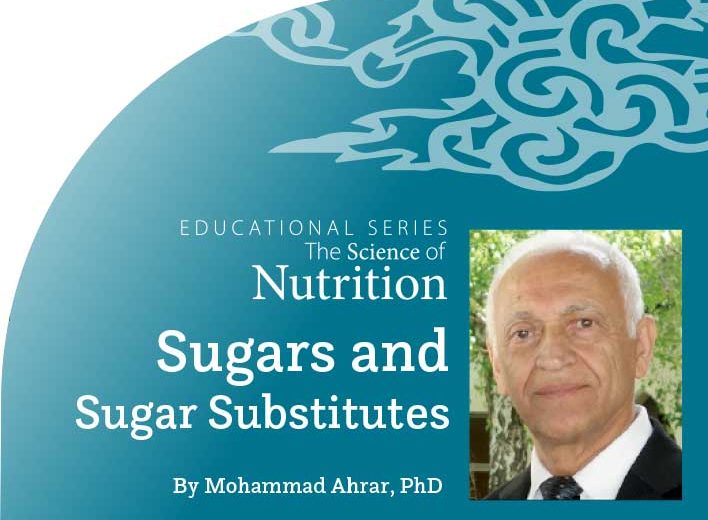Nutritional Value of the
Sugars and Health
By Mohammad Ahrar, PhD
Introduction
Most people have a taste for sugar. We know that consuming foods high in sugars can cause weight gain and other health complications. In this article, we discuss some facts about sugars and how our body handles them.

Basics about sugars
Sugars are synonymous with carbohydrates (commonly known as carbs); by this definition, starch, plant cellulose, and animal glycogen are also considered sugars. In general, sugars refer to glucose, fructose, sucrose, and maltose. Common table sugar (sucrose) is made of glucose and fructose, which is the sweetest of all simple sugars. Milk sugar (lactose) is made of glucose and galactose. Maltose, found in Persian samanu, is made of two glucose molecules.
How do we detect different tastes?
Humans can distinguish between five basic tastes, including sweet, salty, bitter, sour, and umami (a savory flavor, often found in meat). Recently, lipid sensors have been identified on the tongue, which suggests that fat can be considered a sixth taste. Taste processing is first achieved at the level of taste receptor cells or sensors which are clustered in taste buds on the tongue. When the receptors are activated by specific foods, they transmit information via sensory nerves to specific areas in the brain that are involved in taste perception. Sweet taste receptors can be activated by a wide range of chemically different compounds, including sugars (glucose, fructose, sucrose, maltose), artificial sweeteners (e.g., saccharin, aspartame, cyclamate), and some other chemicals.
Are sugars necessary for good health?
In humans, sugars provide quick energy for optimum metabolic reactions in the body cells. The brain is totally dependent on glucose for energy.
Eliminating carbohydrates from the diet can result in severe health problems. When there is no carbohydrate in the diet, the body uses its protein and fat sources as fuel. As a result, the body may lose muscle mass. The body can also metabolize fats to produce energy. But the problem is that high-fat diets (such as some commercial regiments) can, in the long term, accumulate ketones and keto acids in the blood that can cause nausea, fatigue, loss of appetite, and ketoacidosis, which can have serious consequences such as a coma and even death.
It is not necessary to include sugary foods or added sugars in the diet in order for your body to make energy. A diet with adequate complex carbohydrates, such as whole grains, beans, and foods containing natural sugar (such as fruit and milk), will fulfill this role.
Absorption of sugars and carbs
When carbohydrates are consumed, the large molecules must be broken down into simple sugars by digestive enzymes so that they can be absorbed by the small intestine. Likewise, when sucrose is ingested and reaches the small intestine, it will be broken down into glucose and fructose and absorbed, ultimately entering the liver for processing or storage as glycogen.
People who are lactose intolerant, which means they lack the enzyme lactase, may experience irritation of the small intestine, discomfort, and even diarrhea if they consume milk products that contain lactose. When lactose enters the large intestine, bacterial enzymes ferment the sugar and produce different gases and other compounds which can cause more discomfort.
Studies show that fructose is absorbed more slowly from the intestinal tract than is glucose. When glucose and fructose are in equal quantities (1:1 ratio), such as found in sucrose, the absorption rate is rather fast. When sugary foods or drinks that contain different ratios of fructose and glucose are consumed, some fructose may escape the absorption in the small intestine and enter the large intestine.
Fructose digestibility complications
Although sucrose and simple sugars are highly digestible, fructose is not completely absorbed in the small intestine and a good portion of it is transported into the large intestine. Fructose can easily be fermented by the colonic flora and produce fatty acids, carbon dioxide, and other gases which can cause bloating, diarrhea, and gastrointestinal pain. Exercise immediately after consumption of sugary foods exacerbates these symptoms because a greater amount of fructose enters into the large intestine. Fructose was initially thought to be a better choice for diabetics due to its low glycemic index (see Peyk #165). But only liver cells can process fructose, and that’s where the problems begin. In the liver, fructose triggers the production of triglycerides and cholesterol.
High-fructose corn syrup, which is found in many processed foods, is actually a synthetic sugar. It is made from corn syrup and has had some of its glucose converted to fructose enzymatically. High-fructose corn syrup typically contains between 42% and 55% fructose, according to the FDA. Excessive consumption of fructose, especially from sugar-sweetened beverages, may contribute to insulin resistance, obesity, and elevated LDL cholesterol.
Are fruit-based sugars better than other sugars?
Fruits usually contain a balance of glucose and fructose. But fruit isn’t just sugar; it also provides vitamins and minerals such as vitamins A and C, potassium, and folate, as well as fiber, which is good for digestive health. Not to mention, fruits are also packed with antioxidants, which can reduce inflammation and boost the immune system.
Fruit sugar content
The amounts of sugars and the types of sugars in various food sources are not the same. For example, the amount of sucrose in an average apple is about 2 grams per 100 grams of the fruit, while an apricot contains almost three times as much sucrose. Moreover, the percentage of sucrose in fruits also affects their sweetness. For example, orange juice is sweeter than plum juice or pear juice. The table below shows the amount of sugar and the ratio of glucose and fructose in certain fruits.
Note that dried fruit and fruit juice are more calorie-dense and contain more sugar than their fresh counterparts.
Ways to minimize sugar intake and consequences
Portion size: The amount of food we eat is directly related to the caloric value of the food, which influences weight. Portion size is a simple visual factor that can also help us choose the amount of food we need to eat to keep our weight down. The U.S. government mandates that all packaged food products should list the major nutrients and calories in the content. Checking food labels makes it easier to choose the right portion size. Some restaurants may not have the caloric value of their foods listed in the menu, so one simple way to limit caloric intake is to share a meal with your friend or loved ones. You will enjoy the food and the company and reduce your calorie intake in the process. If you crave ice cream, you can get a small cone (87 Calories) rather than a large cone (350 Calories) while still enjoying ice cream. The same is true for any snack or meal; you can enjoy the food and cut the calories in half if you get a small portion or share the plate. You can find more information about portion size in Peyk #189 (September/October 2020).
Dietary fiber: Humans do not have the enzyme to digest fibers. Therefore, fibers will pass through the small intestine undigested. While they provide almost no fuel or energy value to the diet, fibers play an important physiological role in delaying absorption of sugars and reducing the attendant jump in blood glucose level.
Low glycemic index foods: The glycemic index is an index that shows how fast a sugar increases the blood glucose level. Consumption of foods with low glycemic index is a smart dietary decision. For detailed information about the glycemic index, please visit Peyk #165 (September/October 2016). A list of the caloric value of foods and further information about weight control can also be found in Peyk #167 (January/February 2017).
Exercise: Exercise and physical activity in general improve quality of life in various ways—they sharpen memory, relieve mental stress, control blood cholesterol, lower blood pressure, stimulate metabolism, improve the immune system, increase bone strength, and improve sleep quality. The benefits translate to lower risks of cardiovascular disease, hypertension, Type 2 diabetes, osteoporosis, and cancer of the colon and breast. Exercise can also lower the risk of heart disease, help ease arthritis pain, trim your waistline, and preserve your independence. Please find a great detail of information about the effect of exercise on health in Peyk #168 (March/April 2017).
Selected sources
1- Lutz, C. and Przytulski, K: Nutrition and Diet Therapy,
4th ed., F. A Davis Company, Philadelphia (2006).
2- https://www.ncbi.nlm.nih.gov/pmc/articles/PMC5537773/
3- https://www.health.harvard.edu/staying-healthy/which-is-better-high-fructose-corn- syrup-or-table-sugar



















